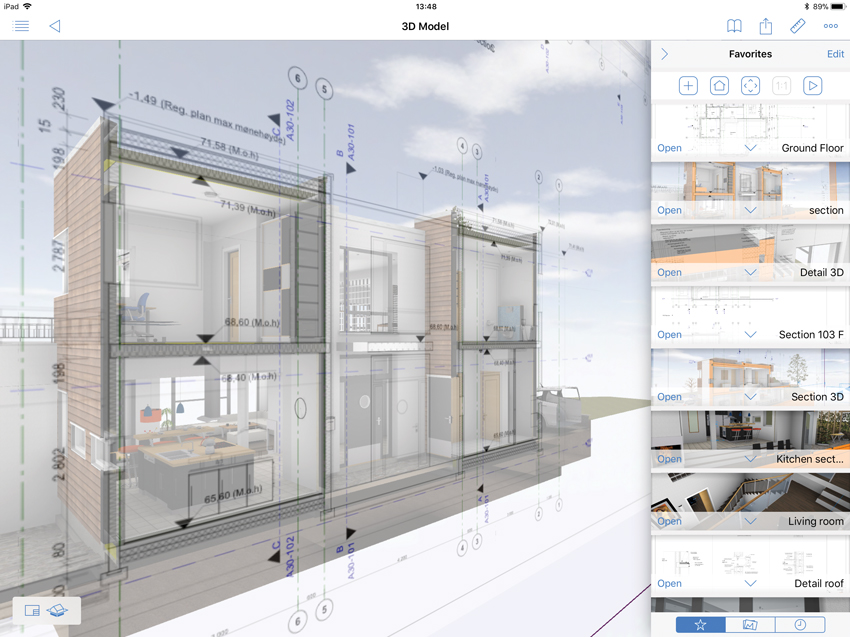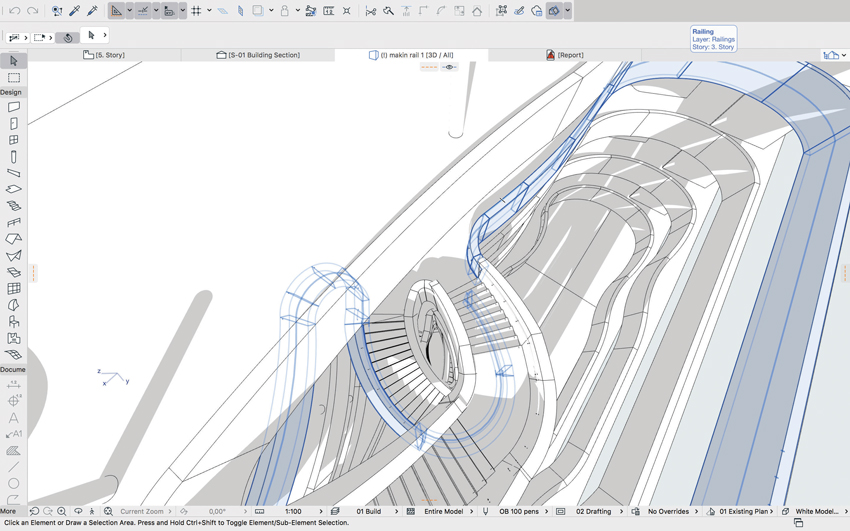The New Benefits of Designing with BIM
 1 AIA LU/Elective; 1 IDCEC CEU/HSW; 0.1 ICC CEU; 0.1 IACET CEU*; 1 AIBD P-CE; AAA 1 Structured Learning Hour; This course can be self-reported to the AANB, as per their CE Guidelines; AAPEI 1 Structured Learning Hour; This course can be self-reported to the AIBC, as per their CE Guidelines.; MAA 1 Structured Learning Hour; This course can be self-reported to the NLAA.; This course can be self-reported to the NSAA; NWTAA 1 Structured Learning Hour; OAA 1 Learning Hour; SAA 1 Hour of Core Learning
1 AIA LU/Elective; 1 IDCEC CEU/HSW; 0.1 ICC CEU; 0.1 IACET CEU*; 1 AIBD P-CE; AAA 1 Structured Learning Hour; This course can be self-reported to the AANB, as per their CE Guidelines; AAPEI 1 Structured Learning Hour; This course can be self-reported to the AIBC, as per their CE Guidelines.; MAA 1 Structured Learning Hour; This course can be self-reported to the NLAA.; This course can be self-reported to the NSAA; NWTAA 1 Structured Learning Hour; OAA 1 Learning Hour; SAA 1 Hour of Core Learning
Learning Objectives:
- Describe how the new stair tool helps to design stair solutions that are safe and easy to navigate and meet all applicable national and local codes.
- Explain how the integrated collision detection feature can reveal potential flaws and weaknesses in the design before construction begins.
- Explore how BIM automates documentation updates and eliminates potential errors or miscommunications that can occur when the documentation is not kept current.
- Provide three examples of how BIM improves the collaboration between architects and the rest of the consulting and engineering team.
- Use new presentation tools in BIM software to engage clients.
This course is part of the Business of Architecture Academy
Using 3-D Architectural BIM Software to Design
The ability to design in 3-D space is one of the most defining features of working in BIM. The software creates a comprehensive 3-D digital model that contains virtual equivalents for the spatial, structural, and mechanical systems included in the project. Designers define the materials, detailing, and spatial characteristics, among other items, in the program, creating layers and layers of metadata that the software uses to generate the 3-D visual representation. As designers interact with the representation, the supporting data is continually updated. This ensures that the incredible amount of information necessary to convey the design intent of a project remains accurate throughout the iterative design process.
Before BIM, architects either drafted buildings manually or with computer-aided design technology, referred to as CAD. Both approaches required architects to design in 2-D, which relied on typing commands into a form to describe the structural and mechanical elements, flesh out the floor plans and elevations, and populate the schedules and sections that comprise the complete drawing set. Once 3-D technology became available, it was only used to create 3-D views and renderings of projects that were designed in 2-D. The 3-D models that could be generated were static, not interactive.

© Villa Funk, Frode Saltkjelvik, GRAPHISOFT Norway
With BIM, architects can design in 2-D or 3-D and modify the design by interacting with the 3-D model of the building.
Now, with BIM, architects can design in 2-D or 3-D and modify the design by interacting with the 3-D model of the building.
This means that designers can still create in the command-driven way they have in the past with a keyboard, or they can use a newer methodology, which essentially allows them to create a building from digital clay, erecting and manipulating the structure more with the mouse than a typed command. For example, instead of pressing Control D to drag an element into a design, the designer can grab it with the mouse and drag it onto the floor plan. Another example of the difference between designing in 2-D and 3-D is that users no longer have to be in a dialogue box to interact with the design—they can do it with a double click.
“I like designing in 3-D a lot more,” explains Allison Cooke, CORE architecture + design, Washington, D.C. “Instead of punching in the characteristics of what you are trying to draw with words and qualifications, this new approach to design helps architects get ideas into a 3-D format more quickly so they can volumetrically study the space.”
Oftentimes, when designing in BIM, architects will work seamlessly between the 2-D and 3-D project views. They will define the dimensional and material qualities of a space in 2-D and see the resulting structure appear in 3-D, getting immediate feedback about how the draft would appear in the real world. Then they can manipulate and interact with the 3-D file.
This flexibility is extremely beneficial throughout the process, especially when designing more complex components, such as the roof. Starting with the edge of the exterior walls or a simple closed polygon outline, multi-plane roofs will model from a conventional roof structure with a few clicks. With BIM, when one plane is modified, the rest of the planes are automatically adjusted to the new geometry. The roof planes can also be edited separately for complex geometries, with the tool calculating new intersections between slopes. The BIM software creates a 3-D model of the roof, enabling an architect to play with the form, change the pitch of the roof by pushing and pulling on the axis, and see the immediate results of the modifications.
New BIM Tools
BIM technology is continuously advancing, adding new capabilities and powerful new tools to the architect’s BIM toolbox. Some of the most impressive new tools now contribute to core architectural design work, helping to create some of the most complex structures and systems in the built environment, including stairs and the railing systems associated with them.
Stair Tool
Designing stairs is one of the most complex tasks in architecture. An acceptable stair design must satisfy special ergonomic considerations, ensuring they are safe and easy to navigate, and meet all applicable national and local codes. Beyond satisfying safety and compliance constraints, another inherent challenge is that the process for creating stairs is especially iterative because the stairs must be reworked whenever changes are made to the greater building structure and consist of multiple subelements, including treads, risers, beams, stringers, and monolithic or cantilevered structures. One exciting new BIM tool employs artificial intelligence to evaluate thousands of design options within the constraints of a specific building and suggest the most optimal stair designs.

Image courtesy of GRAPHISOFT
The new stair tool enables architects to enter a few details about a project and uses artificial intelligence to suggest the most optimal stair designs within the provided constraints.
Using this advanced tool is surprisingly easy. Architects simply enter a few details, such as floor-to-floor height, width of the stairs, rise and run constraints, material composition, the position of the landing, and the specific winder type. Once the pertinent details have been identified, the stair tool is calibrated to review potential stair designs against the defined constraints, ergonomic and safety musts, and applicable code requirements, and then identify the best four stair design solutions. Architects do not need to spend time calculating stair pitch or riser height. They can manipulate the 3-D model with a mouse, reposition the landing, or change the head height, and the tool will reconfigure the stair design automatically in response to the changing parameters. There are also built-in warnings that appear if the design is flawed or impossible as detailed.
Scroll down or click here to see a short video about what the stairs tool can offer.
Railing Tool
Another important new tool creates the complex, associative railings that offer an assist and guidance for people traveling along the stairs created by the stair tool. One of the distinctive features of this tool is that it is not limited to designing railings associated with stairs. The tool views railings as a separate entity and it recognizes that, while a railing can be associative to a flight of stairs, it can also be associative to walls, slabs, roofs, and meshes. Designers can automatically associate railings to several other construction elements, and the geometry of the railing will be automatically updated when the geometry of the host element changes. This tool delivers unique railing patterns specifically designed to fit the needs of a project within the parameters of predefined rules and standards. It is also worth noting that the available associativity options enable the railing tool to develop other building systems as well.

©fjmt
Project: Charles Perkins Centre
Location: Sydney, Australia
Architect: fjmt, fjmtstudio.com
Staircase modeled in BIM
BIM Now Built for Bigger Projects
When BIM was first introduced, computers were equipped with a single core processor. This older technology and limited random access memory (RAM) struggled to churn through the enormous amount of data necessary to build and rebuild the 3-D model. The older technology also had difficulty transitioning between different project views. Back then, architects using BIM spent a lot of time waiting for views to load.
Today, computers feature multi-core processors, fast hard drives, and a lot of RAM. The BIM software has been redesigned to better use the technology now available and apply multithreading techniques and predictive background processing. Those technological improvements coupled with the updates to the BIM software now allow programs to deliver lightning-fast response times and easily handle large, complex models.
These faster BIM solutions effectively harness all available horsepower that a computer has to offer. The program uses all RAM present in a computer, which is one reason it is able to regenerate a 3-D model or project view much more quickly. It also recognizes when current tasks require less than a computer’s full processing power and takes advantage of unused computer capacity to anticipate what a designer may do next and prepare for it in the background.
Making better use of the available processing power allows architects to work in and move through a BIM program much more quickly than they have in the past, but eliminating wait times is not the only way that BIM software improves the efficiency of the design process.











